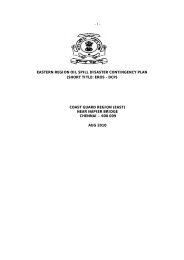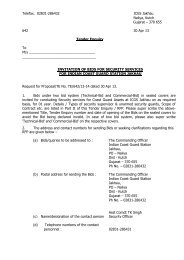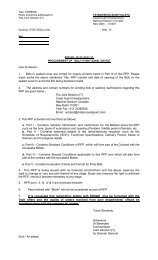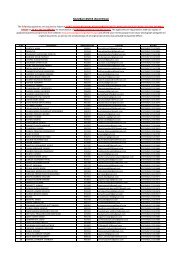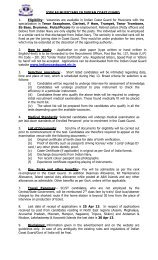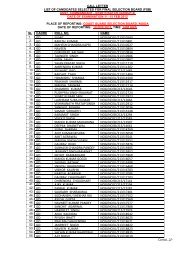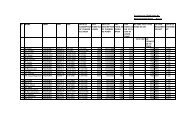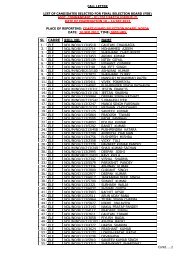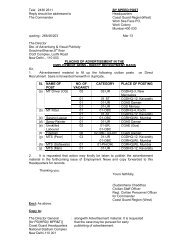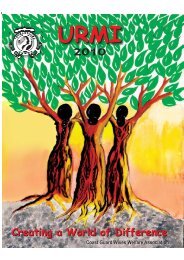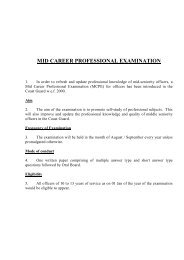Jan 2010 edition - Indian Coast Guard
Jan 2010 edition - Indian Coast Guard
Jan 2010 edition - Indian Coast Guard
You also want an ePaper? Increase the reach of your titles
YUMPU automatically turns print PDFs into web optimized ePapers that Google loves.
Biannual <strong>Jan</strong> <strong>2010</strong> Vol XI Issue 1<br />
A Publication of the <strong>Indian</strong> <strong>Coast</strong> <strong>Guard</strong>
From the Director General’s Desk<br />
The past six months have witnessed two large fuel-laden ships sinking, and a mystery spill that affected<br />
large tracts of coastline near south Gujarat. The quick action initiated by the Paradip and New Mangalore Ports<br />
has resulted in timely removal of residual oil from the sunken ships. The prompt action initiated by the<br />
concerned state governments has ensured quick clean-up of the affected coastal areas. The above action<br />
reflects the objective of the NOSDCP to ensure quick mitigation of an oil pollution incident. However, there is<br />
an immediate necessity to address preventive measures so as to ensure, that the ships are operated with<br />
proper care, their cargo is loaded to prescribed standards, and they carry valid insurance and safety certificates.<br />
I request the maritime administration, port authorities, and all stakeholders to ensure, that the ships that<br />
arrive and depart <strong>Indian</strong> ports, confirm to the prescribed standards of operation.<br />
This <strong>edition</strong> of Blue Waters, deals with issues related to oil spill cleanup through use of sorbent material,<br />
and is aimed at enhancing awareness amongst readers on the recent trends on environment friendly clean-up<br />
measures being instituted worldwide. The sorbent material will be an ideal clean-up gear, that can be provided<br />
to volunteers who are trained on oil spill cleanup.<br />
A pollution response operation is a multi-agency task and require multi-faceted coordination to undertake<br />
large oil spill clean-up, right from the government level to an untrained volunteer worker trying to cleanup the<br />
beaches and affected areas. It requires clear directives, efficient operational coordination, smooth logistics<br />
management, effective manpower utilization, scientific and environment sensitivity input, all working in synergy.<br />
To put the above perspective in to practice, the <strong>Coast</strong> <strong>Guard</strong> conducted the second National Level Pollution<br />
Response Exercise off Mumbai on 09 Nov 09, during which valuable lessons have been learnt with regard to<br />
coordination of utilization of assets and disaster mitigation methods. However, the level and number of agencies/<br />
assets participating in such exercises needs to be increased. The <strong>Coast</strong> <strong>Guard</strong> also undertook joint inspection<br />
of Tier-I facilities of all major ports so as to analyse the existing arrangement and preparedness level for oil<br />
spill cleanup. This is one area which requires more focus as the trend of the recent oil spill incidents indicate,<br />
that ports are very much vulnerable to oil spill incidents and ‘preparedness’ is the key.<br />
Requirement exists to enhance our preparedness to realistically respond to major spill near port areas, as<br />
the existing pollution response capability needs to be augmented, and the essential Tier-I equipment be in<br />
place. The issues which require attention were discussed during the 14 th NOS-DCP meeting and decisions<br />
arrived at, are to be progressed to achieve the desirable standards. Your proactive actions for oil spill preparedness<br />
are the ‘need of the hour’. Our collective resolve will not only bring change to the current marine environment<br />
protection issues, but also enhance our country’s image as a responsible environment friendly nation.<br />
Jai Hind.<br />
New Delhi<br />
31 <strong>Jan</strong> 10<br />
(Anil Chopra)<br />
Vice Admiral<br />
Director General<br />
<strong>Indian</strong> <strong>Coast</strong> <strong>Guard</strong>
<strong>Jan</strong> <strong>2010</strong> Vol X1 Issue 1<br />
Editorial<br />
In this issue of Blue Waters, the theme adopted is<br />
“Use of absorbent for oil spill cleanup”. The key to<br />
effectively combating oil spills is the careful selection and<br />
proper use of Pollution Response equipment and materials<br />
best suited to the type of oil and the conditions that are<br />
prevalent at the spill site. The analysis of recent oil spill<br />
incidents and cleanup measures indicate that the oil spill<br />
absorbent materials in the form of booms, pillows, pads,<br />
rolls and sheets have been used very effectively. The use<br />
of absorbents for cleanup does not require any previous<br />
training or exercise and they are early disposable. It is<br />
no wonder that the authorities responding to MT Hebei<br />
Spirit oil spill that affected South Korea coastlines, were<br />
using about 35 tonnes of absorbent materials everyday<br />
during the shoreline clean-up phase.<br />
Recently, a team from the India Institute of<br />
Technology, Delhi has taken a initiative to undertake R&D<br />
on preparing low cost oil spill absorbent material, which<br />
can be re-used many times. The research is still ongoing,<br />
and the availability such locally made absorbent materials<br />
will be of great advantage as it will be cheaper, the quality<br />
can be varied in accordance to the requirement. Every<br />
Port and Oil handling agencies should have some amount<br />
of absorbent material in their inventory for addressing<br />
any minor spills.<br />
The past six months have seen a rise in adoption of<br />
resolutions by IMO, many of which are related to air<br />
pollution, ballast water management and ship recycling.<br />
However, information related to current issues such as<br />
mandatory audit scheme, ship to ship oil transfer Rules,<br />
oil residue MARPOL amendments are brought out in this<br />
<strong>edition</strong> for benefit of the readers.<br />
The measures discussed during the 14 th NOS-DCP<br />
meeting need to be addressed by all concerned for<br />
establishing necessary oil spill response capability in ports<br />
and oil handling facilities. The <strong>Coast</strong> <strong>Guard</strong> is likely to<br />
enter into MoU with AMET University for conduct of IMO<br />
Level – II PR course regularly at Chennai. The information<br />
brochure will be forwarded shortly to all resources<br />
agencies. The IMO Level – I oil spill response training<br />
progress for the year <strong>2010</strong> has been drawn up and hosted<br />
in ICG website. The resource agencies may benefit from<br />
the <strong>Coast</strong> <strong>Guard</strong> efforts by nominating their representative<br />
for the fresh or refresher training.<br />
(Donny Michael)<br />
Commandant<br />
Joint Director (Environment)<br />
ARTICLES<br />
Use of Absorbents for 3<br />
Oil Spill Clean up<br />
Experiment to Clean Up 10<br />
an Oil Spill<br />
IMO NEWS<br />
Mandatory Audit Scheme 12<br />
IMO Legal Committee clarifies 12<br />
Bunkers Convention certificates<br />
MEPC adopts ship to ship 13<br />
Oil Transfer Rules<br />
Oil residue - MARPOL amendments 13<br />
Ballast water - New Guidance 14<br />
Ship-recycling implementation guidelines 14<br />
REPORTS<br />
India Watch<br />
Oil Spill in South Gujarat 15<br />
Sinking of MV Asian Forest 15<br />
off Mangalore on 18 Jul 2009<br />
Removal of Oil 16<br />
EVENTS<br />
14 th NOS-DCP Meeting 17<br />
National Level Pollution 18<br />
Resonse Exercise (NATPOLREX)<br />
International <strong>Coast</strong>al Cleanup Day 19<br />
INFORMATIONS<br />
CONTENTS<br />
Grounding & Sinking incidents of 20<br />
merchant vessels in <strong>Indian</strong> waters<br />
from Jun-Dec 2009<br />
<strong>Indian</strong> <strong>Coast</strong> <strong>Guard</strong> Annual Pollution 21<br />
Response Training Programme - <strong>2010</strong><br />
Minor and Major Oil Spills 22<br />
in <strong>Indian</strong> waters (since 1982)
ARTICLES<br />
<strong>Jan</strong> <strong>2010</strong> Vol X1 Issue 1<br />
USE OF ABSORBENTS FOR<br />
OIL SPILL CLEAN UP<br />
Introduction<br />
BY COMDT(JG) MK BHAT, 4075-L<br />
BS RAMAN, U/ADH(ME), 00599-Q<br />
SATISH KUMAR, ADH(P), 02419-Y<br />
A number of advanced response mechanisms are<br />
available for controlling oil spills and minimizing their<br />
impacts on human health and the environment. The key<br />
to effectively combating spills is careful selection and proper<br />
use of the equipment and materials best suited to the<br />
type of oil and the conditions at the spill site. Most spill<br />
response equipment and materials are greatly affected by<br />
such factors as conditions at sea, water currents, and wind.<br />
Damage to spill-contaminated shorelines and dangers to<br />
other threatened areas can be reduced by timely and<br />
proper use of containment and recovery equipment. One<br />
of the best suitable method of recovery of spilled oil in<br />
shoreline is usage of absorbents.<br />
Absorbent Technologies.<br />
Sorbents are insoluble materials or mixtures of<br />
materials used to recover liquids through the mechanism<br />
of absorption, or adsorption, or both. Absorbents are<br />
materials that pick up and retain liquid distributed<br />
throughout its molecular structure causing the solid to swell<br />
(50 percent or more). The absorbent must be at least 70<br />
percent insoluble in excess fluid. Adsorbents are insoluble<br />
materials that are coated by a liquid on its surface, including<br />
pores and capillaries, without the solid swelling more than<br />
50 percent in excess liquid. To be useful in combating oil<br />
spills, sorbents need to be both oleophilic (oil-attracting)<br />
and hydrophobic (water-repellent). Although they may be<br />
used as the sole cleanup method in small spills, sorbents<br />
are most often used to remove final traces of oil, or in<br />
areas that cannot be reached by skimmers. Sorbent<br />
materials used to recover oil must be disposed of in<br />
accordance with approved local, state and federal<br />
regulations. Any oil that is removed from sorbent materials<br />
must also be properly disposed off or recycled.<br />
Categories of Sorbents.<br />
Sorbents can be divided into three basic categories:<br />
natural organic, natural inorganic, and synthetic.<br />
(a) Natural Organic Sorbents. This includes peat<br />
moss, straw, hay, sawdust, ground corncobs,<br />
feathers, and other readily available carbon-based<br />
products. Organic sorbents can adsorb between 3 and<br />
15 times their weight in oil, but there are disadvantages<br />
to their use. Some organic sorbents tend to adsorb<br />
water as well as oil, causing the sorbents to sink. Many<br />
organic sorbents are loose particles such as sawdust,<br />
and are difficult to collect after they are spread on the<br />
water. These problems can be counterbalanced by<br />
adding flotation devices, such as empty drums attached<br />
to sorbent bales of hay,to overcome the sinking issue,<br />
and wrapping loose particles in mesh to aid in<br />
collection.<br />
3
<strong>Jan</strong> <strong>2010</strong> Vol X1 Issue 1<br />
(b) Natural Inorganic Sorbents. Consist of clay,<br />
perlite, vermiculite, glass wool, sand, or volcanic ash.<br />
They can adsorb from 4 to 20 times their weight in<br />
oil. Inorganic sorbents, like organic sorbents, are<br />
inexpensive and readily available in large quantities.<br />
These types of sorbents are not used on the water’s<br />
surface.<br />
(c) Synthetic Sorbents. This includes manmade<br />
materials that are similar to plastics, such as<br />
polyurethane, polyethylene, and polypropylene and<br />
are designed to adsorb liquids onto their surfaces.<br />
Other synthetic sorbents include cross-linked polymers<br />
and rubber materials, which absorb liquids into their<br />
solid structure, causing the sorbent material to swell.<br />
Most synthetic sorbents can absorb up 70 times their<br />
own weight in oil.<br />
and catch oil products around machinery and ways.<br />
(b) Blue. Oil only material that picks up oil<br />
(hydrocarbon based) liquids. Repels and floats on<br />
water (hydrophobic). Product is used in the spill<br />
response and MRO industries, to pick up oil off water<br />
and catch oil products around machinery.<br />
(c) Grey. Universal material that picks up all<br />
liquids (Hydrophilic). It does not float on water.<br />
Product is used in the spill response, HAZ-Mat and<br />
MRO industries. This product can handle aggressive<br />
liquids.<br />
(d) Yellow. Universal material that picks up all<br />
liquids. The colour “Yellow” signifies the type of Haz-<br />
Mat liquid absorbed as per individual company<br />
guidelines, for proper disposal. It does not float on<br />
water. Product is used in the spill response, HAZ-<br />
Mat and MRO industries. This product can handle<br />
aggressive liquids.<br />
(e) Other colours. Each colour has a specific<br />
industry meaning. Green is used to blend in with the<br />
natural surroundings, Pink is used for acids, Red is<br />
used for Bio hazard. And of course you have a few<br />
manufactures creating coloured pads for the sake of<br />
marketing. Colour has absolutely nothing to do with<br />
the performance and active properties of the pad. It is<br />
used primarily for a identifier for the spill responder<br />
and the person or company handling the spill.<br />
Characteristics<br />
The characteristics must be considered when<br />
choosing sorbents for cleaning up oil spills:<br />
Sorbent Colour<br />
(a) White. Oil only material that picks up oil<br />
(hydrocarbon based) liquids. Repels and floats on<br />
water (hydrophobic). Product is used in the spill<br />
response and MRO industries, to pick up oil off water<br />
(a) Rate of Absorption. The absorption of oil is<br />
faster with lighter oil products. Once absorbed the oil<br />
cannot be re-released. Effective with light hydrocarbons<br />
(e.g., gasoline, diesel fuel, benzene).<br />
(b) Rate of Adsorption. The thicker oils adhere to<br />
the surface of the adsorbent more effectively.<br />
4
<strong>Jan</strong> <strong>2010</strong> Vol X1 Issue 1<br />
(c) Oil Retention. The weight of recovered oil can<br />
cause a sorbent structure to sag and deform, and when<br />
it is lifted out of the water, it can release oil that is<br />
trapped in its pores. Lighter, less viscous oil is lost<br />
through the pores more easily than are heavier, more<br />
viscous oils during recovery of adsorbent materials<br />
causing secondary contamination.<br />
(d) Ease of application. Sorbents may be applied<br />
to spills manually or mechanically, using blowers or<br />
fans. Many natural organic sorbents that exist as loose<br />
materials, such as clay and vermiculite, are dusty,<br />
difficult to apply in windy conditions, and potentially<br />
hazardous if inhaled.<br />
Sorbent Class<br />
(a) Universal. This class of sorbents can pick up<br />
any oil or water base liquid including aggressive liquids<br />
such as acids or caustics. The term most commonly<br />
used to describe this type of sorbent is Hydrophilic.<br />
The color of the sorbent is used as an identifier and to<br />
tell the person handling the spill its purpose of the<br />
pad.<br />
(b) Oil Only. This class of sorbents can pick only<br />
oil based liquids. The term most commonly used to<br />
describe this type of sorbent is Hydrophobic. The color<br />
of the sorbent is used as an identifier and to tell the<br />
person handling the spill its purpose of that pad.<br />
Generally theses sorbents are white. However blue is<br />
also an identifier of oil only.<br />
Sorbent Type<br />
Sorbents are materials used to recover liquids (leaks,<br />
drips, spills, etc.). Synthetic sorbents are made of<br />
polypropylene - a type of plastic - and are designed to<br />
adsorb liquids onto their surfaces, while more basic<br />
sorbents like rags, corn cobs, recycled cellulose,<br />
vermiculite or clay actually absorb the liquids into the<br />
material itself.<br />
Polypropylene is a petroleum based product, and will<br />
naturally repel water while adsorbing any oil or oil-based<br />
liquids. Water-based spills can be absorbed by<br />
polypropylene products after they are treated with a<br />
surfactant. Often these products are colour coded to help<br />
the user select the correct one.<br />
Consider how to dispose of the sorbents prior to<br />
purchasing them. If you plan to apply any spilled material<br />
that has been absorbed, it must be easily handled for<br />
dispersal at or below the labelled rate to a labelled site. If<br />
you select a material, like a pad, that cannot be applied,<br />
have a plan for how to dispose of the material (state<br />
sponsored clean-sweep hazardous waste collection, or<br />
private hazardous waste contractor). All materials<br />
for disposal require proper identification of the<br />
contents (product name, active ingredient, approximated<br />
amount).<br />
There are three general types of sorbents, as mentioned<br />
below :<br />
(a) Universal Sorbents. Will absorb any liquid<br />
including aggressive<br />
liquids, such as acids<br />
and bases and are<br />
flexible enough to soak<br />
up cleaners, waterbased<br />
fluids, alcohol<br />
and gasoline. Universal<br />
sorbets may be made<br />
from polypropylene<br />
treated with a surfactant<br />
or expanded silicates.<br />
(b) Petroleum<br />
Sorbents. These are<br />
designed to absorb oil or<br />
other petroleum-based liquids. They will not absorb<br />
any water-based liquids. These sorbents are made of<br />
polypropylene or treated cellulose.<br />
5
<strong>Jan</strong> <strong>2010</strong> Vol X1 Issue 1<br />
(c) Maintenance Sorbents. These are designed<br />
to absorb non-aggressive liquids found in industrial<br />
and business operations. Some are made of recycled<br />
cotton, wool, paper or corn cobs. There are also some<br />
made of polypropylene.<br />
(c) Pads and Rolls. Used to catch drips and leaks<br />
as they occur. These can be used in high-traffic aisles<br />
or next to machines. Pads can be laid under machines,<br />
or valves.<br />
Forms of Sorbents<br />
(a) Booms, Socks or Mini Booms. These can be<br />
placed around a spill or machine to keep the liquid<br />
from moving.<br />
(d) Loose Sorbents. These are granules formulated<br />
to absorb liquids when poured on the spill. Loose<br />
sorbents are typically used on small liquid spills.<br />
(b) Pillows. Are good for absorbing large spills of<br />
liquids. They may also be used in maintenance mode<br />
for recurring leaks from valves or pipes.<br />
Effectiveness<br />
Sorbents work on two principles: absorption and<br />
adsorption. In most cases sorbent materials are broadcast<br />
upon an oil slick and float along its surface until they<br />
become saturated with oil. Then the oil-soaked sorbents<br />
6
<strong>Jan</strong> <strong>2010</strong> Vol X1 Issue 1<br />
must be recovered and disposed off or squeezed free of<br />
oil and re-used.<br />
Sorbents are not recognized as a primary means of<br />
recovering most oil spills for several reasons :-<br />
(a) The application and recovery of sorbent products<br />
is labour intensive activities.<br />
(b) The problems associated with disposal of oily<br />
sorbents are considerable.<br />
(c) The costs of using sorbents as a primary recovery<br />
tool are prohibitive.<br />
Even if sorbents are re-used time and again, the<br />
labour necessary to support such recovery efforts makes<br />
it uneconomical to use sorbents. Consequently, sorbents<br />
are not recommended as a primary recovery tool. Rather,<br />
they should be used in mopping up operations, removing<br />
sheens, and in areas where conventional skimming<br />
devices are ineffective.<br />
In simple terms absorbents serve to soak<br />
up spilled products by capillary action. These types of<br />
sorbents resemble sponges in both form and function,<br />
and are ideal for low viscosity oil and fuel spills on land<br />
or water.<br />
“Oil Only” and “Universal” Sorbents are used to<br />
efficiently adsorb leaks, drips, and spills. The “Oil Only”<br />
type adsorbs hydrocarbon based fluids while repelling<br />
water (oleophillic and hydrophobic). “Universal” sorbents<br />
are designed to absorb most any fluid except “Hydroflouric<br />
Acid”. These sorbents are made from 100% MeltBlown<br />
Polypropylene and are non-toxic, non-hazardous, and<br />
non-biodegradable. Polypropylene sorbents are easily<br />
deployed and retrieved without special equipment or<br />
specially trained personnel.<br />
Metal clips link Sorbent booms together for adding<br />
extra lengths.<br />
Oil sorbent booms are ideal for rivers, ponds, oceans<br />
or where fuel spills occur.<br />
Adsorbents rely on the forces of molecular adhesion<br />
that cause heavy oil products to cling to the surface of the<br />
sorbent, the oil simply sticks to the sorbent material. Snare,<br />
also called pom-poms, nets, and multi-strand sorbents are<br />
most effective on viscous oils.<br />
Re-Use<br />
The best option for sorbents with uncontaminated used<br />
oil (petroleum-based or synthetic) is to recycle them by<br />
following the used oil regulations. Some oil sorbent<br />
recyclers compress or wring<br />
out sorbents to recover<br />
liquid oil and produce bunker<br />
fuel. Sorbents also provide<br />
fuel for municipal power<br />
plants and for industrial<br />
furnaces. Be sure your oil<br />
sorbent recycler actually<br />
recycles your non-hazardous<br />
sorbents as used oil. (Some companies accept nonhazardous<br />
sorbents, but manage them as if they were<br />
hazardous waste.)<br />
Most sorbents containing uncontaminated motor oil<br />
can be put in the dumpster as long as there are no free<br />
liquids.<br />
7
<strong>Jan</strong> <strong>2010</strong> Vol X1 Issue 1<br />
Sorbents may be re-used numerous times before the<br />
sorbent begins to deteriorate. The re-use potential of a<br />
sorbent may appear to be an advantage to other methods<br />
but the process of applying the sorbent, recovering it,<br />
wringing it free of oil, and reapplying it is labour intensive,<br />
time consuming and expensive, in addition to creating<br />
the problem of disposal in conventional landfills.<br />
Sorbents are used to absorb drips or spilled liquids,<br />
especially used oil. Sorbents are made from a variety of<br />
materials, ranging from plastic resin pads to sawdust.<br />
Used sorbents have commonly been disposed of as solid<br />
waste; however, they can contain a variety of liquids,<br />
including hazardous materials.<br />
Sorbents used to absorb hazardous materials, such<br />
as solvents, paint, ink or oil, may need special handling<br />
and disposal. Testing and special handling is required for<br />
sorbent used to clean up used oil before it is disposed of.<br />
Used oil sorbent disposed of as industrial solid waste must<br />
contain no free liquids, and must be evaluated and shown<br />
to be nonhazardous. No quantity of used oil sorbents can<br />
be disposed of as solid waste without documentation that<br />
the sorbents are not hazardous. Other options for used<br />
oil sorbents are to: launder or wring out and reuse when<br />
possible, burn for energy recovery or dispose of as<br />
hazardous waste.<br />
All of the options for recycling or disposing of sorbent<br />
waste cost money. The easiest cost savings result from<br />
careful work practices that reduce the amount of sorbent<br />
waste produced.<br />
(ii) Avoid spills by increasing awareness of the<br />
cost of spill cleanup and waste management.<br />
(iii) Minimize the number of trips and the<br />
distance during materials transfers to reduce the<br />
chance of accidental spills.<br />
(iv) Always recover liquids as liquids, before<br />
using sorbents.<br />
(v) Use a squeegee and dustpan to clean up<br />
non-flammable liquids. This can recover up to 95<br />
percent of the spilled liquid, at a cost of about<br />
$10 for tools. This technique also greatly reduces<br />
the amount ofsorbent needed to clean up any<br />
remaining liquid residue, and it only takes one<br />
quick, extra step.<br />
(b) Keep sorbents that contain hazardous materials<br />
separate from nonhazardous sorbent waste. This helps<br />
reduce the volume of sorbent that needs to be<br />
managed as hazardous waste. Be sure to label storage<br />
containers accurately.<br />
(c) Collect and store partially used sorbent in specially<br />
labeled containers located in high-use areas. Partially<br />
used sorbent can be reused until it is saturated.<br />
Disposal Issues<br />
Sorbents used to treat free liquids to be disposed of in<br />
landfills must be nonbiodegradable. such as Inorganic<br />
Suggestions for Reducing Sorbent Waste<br />
and Cost<br />
(a) Encourage operators to practice good<br />
housekeeping:<br />
(i) Use drip pans to catch liquids directly,<br />
rather than soaking up with sorbents.<br />
8
<strong>Jan</strong> <strong>2010</strong> Vol X1 Issue 1<br />
minerals, other inorganic materials, and elemental carbon<br />
(e.g.) aluminosilicates, clays, smectites, Fuller’s earth,<br />
bentonite, calcium bentonite, montmorillonite, calcined<br />
montmorillonite, kaolinite, micas (illite), vermiculites,<br />
zeolites; calcium carbonate (organic free limestone);<br />
oxides/hydroxides, alumina, lime, silica (sand),<br />
diatomaceous earth; perlite (volcanic glass); expanded<br />
volcanic rock; volcanic ash; cement kiln dust; fly ash; rice<br />
hull ash; activated charcoal/activated carbon); or<br />
High molecular weight synthetic polymers (e.g.)<br />
polyethylene, high density polyethylene (HDPE),<br />
polypropylene, polystyrene, polyurethane, polyacrylate,<br />
polynorborene, polyisobutylene, ground synthetic<br />
rubber, cross-linked allylstyrene and tertiary butyl<br />
copolymers). This does not include polymers derived<br />
from biological material or polymers specifically designed<br />
to be degradable; or Mixtures of these non biodegradable<br />
materials.<br />
Handling, storage, and disposal of products must be<br />
carried out in compliance with all local, state, and federal<br />
regulations. Various liquids absorbed may be toxic or<br />
hazardous in nature and should be disposed of in the<br />
approved manner. The manufacturer does not recommend<br />
any specific disposal procedures.<br />
Case Study<br />
(a) <strong>Coast</strong>al Oil Spills benefit from the use of<br />
absorbents: On 20 June 1994, the Apollo Sea sank<br />
between Dassen and Robben islands. Oil came ashore<br />
on Dassen Island at West Bay and House Bay, and<br />
later also on Robben Island. This resulted in about<br />
10000 penguins being oiled, of which 4718 were<br />
successfully cleaned by Southern African National<br />
Foundation for the Conservation of <strong>Coast</strong>al Birds<br />
(SANCCOB) and later returned to the wild. The other<br />
5000 birds died, many during transportation from the<br />
islands to SANCCOB’s rescue stations or in the first<br />
few days after<br />
arriving at the<br />
stations. Before<br />
the sinking of<br />
Treasure, the<br />
Apollo Sea<br />
incident was<br />
the largest<br />
oiling event<br />
for seabirds in<br />
southern Africa.<br />
Soon after<br />
Treasure sank,<br />
it became<br />
apparent that a much larger number of birds was at<br />
risk of becoming oiled, and that unless steps were<br />
taken to minimize this number, it may prove beyond<br />
the capacity of SANCCOB to care for. This case study<br />
highlights steps that were taken to minimize the<br />
numbers of birds that became oiled and remedial<br />
measures that were implemented for those that were<br />
oiled.<br />
(b) Firstly, attempts were made to catch all penguins;<br />
congregating rocks contaminated with oil were initially<br />
piled together and dusted with an absorbent peatbased<br />
dust that rendered them dry. They were later<br />
returned to the beach area. The rocky coastline and<br />
intertidal region were cleaned by rubbing fine absorbent<br />
material into the oil on the rocks and brushing it off<br />
with hard bristle brushes. Kelp contaminated with oil<br />
was removed and buried on the island. A survey<br />
showed the Robben Island coastline to be mostly clean<br />
of oil on 5 July.<br />
(c) This experience demonstrates the amazing speed<br />
and ecological benefits of using absorbents for oil spill<br />
cleanup. This product offers a fast and environmentally<br />
friendly method for protecting the eco-system,<br />
including plant and wildlife during oil spill disasters.<br />
9
<strong>Jan</strong> <strong>2010</strong> Vol X1 Issue 1<br />
With this product, the project was cleaned up in<br />
record time, not YEARS! In the case of this project,<br />
within one month the beaches were clean and<br />
absorbents made the difference in the death toll of<br />
the local wildlife.<br />
sponge, styrofoam cup,<br />
garden peat moss)<br />
● 1 squirt of liquid<br />
dishwashing detergent<br />
EXPERIMENT TO CLEAN UP<br />
AN OIL SPILL<br />
●<br />
●<br />
tweezers or tongs<br />
bird feathers<br />
An environment friendly oil spill experiment<br />
(Courtesy AMSA, Australia)<br />
Do you want to try cleaning up an oil spill yourself?<br />
This experiment will help you understand why it is such<br />
a difficult task. All of the tools you will need are<br />
environmentally friendly and easy to find.<br />
You need to have the following for the experiment:<br />
●<br />
●<br />
one 28 cm x 19 cm x 4 cm<br />
clear glass baking dish<br />
(or equivalent)<br />
water<br />
To prepare the fresh water<br />
●<br />
●<br />
●<br />
Fill baking dish with cold<br />
tap water within 1 cm of<br />
rim.<br />
Add 5-6 drops of food dye.<br />
Mix dye and water with a<br />
stirring stick. Let solution<br />
settle.<br />
Answer question 1 in Observations.<br />
●<br />
blue food colouring<br />
To simulate crude oil<br />
●<br />
●<br />
●<br />
12 tbsp. vegetable oil<br />
8 tbsp. pure cocoa powder<br />
1 tsp. table salt<br />
●<br />
●<br />
Place 3 tbsp. of vegetable<br />
oil in mug.<br />
Add 2 tbsp. of cocoa<br />
powder.<br />
●<br />
a tablespoon<br />
●<br />
Mix cocoa powder and oil<br />
●<br />
a teaspoon<br />
thoroughly with a paddle<br />
pop stick.<br />
●<br />
●<br />
5 paddle-pop sticks<br />
a coffee mug<br />
To contaminate fresh water<br />
●<br />
sorbents (paper towel,<br />
cotton balls, rag, string,<br />
nylon pot scrubber,<br />
●<br />
Very slowly pour simulated<br />
crude oil from a height of<br />
1 cm onto the top of the<br />
fresh water dish. If you<br />
10
<strong>Jan</strong> <strong>2010</strong> Vol X1 Issue 1<br />
pour the oil too quickly,<br />
the experiment won’t<br />
work.<br />
Questions on Observations<br />
●<br />
How is the fresh water/ocean different from tap<br />
water?<br />
Answer question 2 in Observations.<br />
Wait 3 minutes.<br />
Do you want to change your answer to question 2 in<br />
Observations?<br />
To test the sorbents<br />
●<br />
Place a small sorbent<br />
sample into the centre<br />
top of the contaminated<br />
fresh water.<br />
Answer questions 3, 4, 5 and 6 in Observations.<br />
Remove sorbent with tweezers or tongs.<br />
Repeat step 1 with other sorbent samples.<br />
Answer questions 7, 8, 9 and 10 in Observations.<br />
Clean out contaminated fresh water.<br />
Prepare new simulated fresh water following<br />
instructions above.<br />
Add detergent to the oil-contaminated fresh water.<br />
Answer questions 11, 12 and 13 in Observations.<br />
To determine how oil affects feathers<br />
Dip feather into oil-contaminated fresh water.<br />
Answer questions 14 and 15 in Observations.<br />
Repeat all of the above procedures substituting an<br />
ocean for the fresh water. To prepare the ocean, follow<br />
the fresh water procedures except add 1 tsp. of salt and<br />
mix it with the water before step 2.<br />
At the end of the ocean experiments, answer question<br />
16 in Observations.<br />
●<br />
●<br />
●<br />
●<br />
●<br />
●<br />
●<br />
●<br />
●<br />
●<br />
●<br />
●<br />
●<br />
●<br />
●<br />
What happened to the oil when you dropped it<br />
on the fresh water/ocean? Did it sink? Float? Mix<br />
in?<br />
How much oil did the sorbent clean up? How<br />
quickly?<br />
Does the sorbent pick up water too? If so, how<br />
can you tell?<br />
Does the sorbent sink or float?<br />
What is the condition of the contaminated<br />
sorbent?<br />
How would you pick up the oil-contaminated<br />
material in a “real” oil spill in fresh water/the<br />
ocean?<br />
How would you dispose of the oil-contaminated<br />
material in a real oil spill?<br />
Of the sorbents you tested, which one worked<br />
the fastest? The best?<br />
What other materials could you use as sorbents?<br />
What happened when the detergent was added<br />
to the contaminated fresh water/ocean?<br />
Where would the oil go in “real” fresh water/ocean<br />
after a dispersant (like the dishwashing detergent<br />
is used?<br />
How clean is the fresh water/ocean now that it<br />
has dishwashing liquid in it?<br />
What happens when a feather gets oil on it?<br />
How might an oiled feather affect a bird?<br />
Are the results of the experiment different when<br />
you use fresh water instead of an ocean?<br />
11
IMO NEWS<br />
<strong>Jan</strong> <strong>2010</strong> Vol X1 Issue 1<br />
MANDATORY AUDIT SCHEME<br />
The IMO Council has approved, in principle, a fiveyear<br />
plan that would see the Voluntary IMO Member State<br />
Audit Scheme phased in as an institutionalized, mandatory<br />
scheme. The Council requested the Secretariat to prepare<br />
a resolution delineating the way forward, together with a<br />
proposed timeframe and schedule for the further<br />
development of the Audit Scheme, for consideration and<br />
approval by the next session of the Council, for submission<br />
to the IMO Assembly for adoption, both scheduled to be<br />
held in November 2009. Such a timeframe would entail,<br />
in principle, the introduction of appropriate requirements<br />
in the relevant mandatory IMO instruments, with<br />
consequential amendments to these being adopted<br />
possibly in 2013, for subsequent entry into force in <strong>Jan</strong>uary<br />
2015. A resolution on the framework and procedures for<br />
the new phase of the scheme would also need to<br />
be adopted by the IMO Assembly, with preparatory<br />
work for<br />
commencement<br />
of an<br />
institutionalized<br />
scheme<br />
following<br />
thereafter.<br />
Under the<br />
current<br />
scheme, the<br />
first audits<br />
were carried<br />
out in 2006<br />
and, to date,<br />
53 IMO<br />
Member<br />
States and one Associate Member have volunteered for<br />
audit and 38 audits have been completed.<br />
Meanwhile, the Council encouraged Member States that<br />
have not yet volunteered for audits to do so as and when<br />
they are ready, and as early as possible, and invited Member<br />
States to nominate qualified auditors who can be selected<br />
for audit teams and who can participate in the related<br />
training courses convened by the Organization.<br />
IMO LEGAL COMMITTEE CLARIFIES<br />
BUNKERS CONVENTION<br />
CERTIFICATES<br />
IMO’s Legal Committee moved to resolve possible<br />
confusion over some aspects of the implementation of the<br />
International Convention on Civil Liability for Bunker Oil<br />
Pollution Damage, 2001 (Bunkers Convention), when it<br />
met for its 96th session, with the approval of a draft<br />
Assembly resolution on the issuing of bunker certificates<br />
of insurance to bareboat-registered vessels.<br />
The draft resolution aims to clarify differing<br />
interpretations on the issuance of Bunker Certificates by<br />
States to ships registered in a bareboat registry (in other<br />
words, when a vessel is temporarily permitted to fly the<br />
flag of another country, while ownership continues to be<br />
registered in the underlying registry), by stating that, while<br />
all States Parties recognize that Bunker Certificates should<br />
be issued by the flag State if it is a Party to the Convention,<br />
“all State Parties should request only one Bunker Certificate<br />
from any ship, including ships bareboat-registered in a<br />
State Party, and should accept Bunker Certificates issued<br />
by such a State Party”. This is intended to assist shipowners,<br />
managers and operators in avoiding unnecessary delays,<br />
detentions of ships, and administrative burdens.<br />
12
<strong>Jan</strong> <strong>2010</strong> Vol X1 Issue 1<br />
Further recommendations state that: “State Parties<br />
should avoid burdening shipowners with unnecessary<br />
bureaucracy; and State Parties which allow ships to be<br />
registered as bareboat chartered should co operate to find<br />
viable solutions in a spirit of understanding and<br />
cooperation.” The draft resolution will be submitted to the<br />
26th session of the IMO Assembly for adoption.<br />
Mandatory financial security for<br />
abandonment<br />
The Committee reviewed the report of the ninth<br />
session of the joint IMO/International Labour Organization<br />
(ILO) Ad Hoc Expert Working Group, and agreed with the<br />
Group’s recommendations to make mandatory, by means<br />
of proposed amendments to the ILO’s Maritime Labour<br />
Convention (MLC), 2006, financial security in case of<br />
abandonment of seafarers and in respect of contractual<br />
claims for personal injury to or death of seafarers.<br />
The joint group’s report will also be submitted to the<br />
306th Session of the Governing Body of ILO. The Legal<br />
Committee agreed that an amendment to the MLC 2006<br />
represented the best way forward to create such a<br />
mandatory instrument or instruments, but noted that this<br />
convention was not yet in force, and further work on the<br />
draft amendments might be needed after its entry into<br />
force. It was also noted that the financial security<br />
envisaged in the draft text was restricted to contractual<br />
compensation as provided for under the employment<br />
contract, collective bargaining agreement or other<br />
employment agreement.<br />
MEPC ADOPTS SHIP TO SHIP OIL<br />
TRANSFER RULES<br />
The MEPC adopted amendments to MARPOL Annex I<br />
for the prevention of marine pollution during some shipto-ship<br />
(STS) oil transfer operations. The amendments<br />
are expected to enter into force on 1 <strong>Jan</strong>uary 2011.<br />
The new chapter 8 on Prevention of pollution during<br />
transfer of oil cargo between oil tankers at sea will apply<br />
to oil tankers of 150 gross tonnage and above and will<br />
require any oil tanker involved in oil cargo STS operations<br />
to carry a plan prescribing how to conduct STS operations<br />
(the STS Plan), which would be approved by its<br />
Administration.<br />
Notification to the relevant coastal State will be required<br />
not less than 48 hours in advance of the scheduled STS<br />
operations, although some relaxation to this rule is allowed<br />
in certain, very specific, cases. The regulations are not<br />
intended to apply to bunkering operations. Consequential<br />
amendments to the International Oil Pollution Prevention<br />
(IOPP) Certificate, the Supplement to the IOPP Certificate<br />
and the Oil Record Book were also adopted.<br />
OIL RESIDUE - MARPOL<br />
AMENDMENTS<br />
Amendments to MARPOL Annex I regulations relating<br />
to the on-board management of oil residue (sludge), were<br />
adopted. They clarify long-standing requirements and<br />
remove existing ambiguities in order to facilitate<br />
compliance. Definitions for oil residue (sludge), oil<br />
residue (sludge) tanks, oily bilge water and oily bilge<br />
water holding tanks are introduced for the first time.<br />
Related amendments to the Supplement to the IOPP<br />
Certificate, Form A and Form B, and to the Oil Record<br />
13
<strong>Jan</strong> <strong>2010</strong> Vol X1 Issue 1<br />
Book were also adopted. The amendments are expected<br />
to enter into force on 1 <strong>Jan</strong>uary 2011.<br />
SHIP-RECYCLING<br />
IMPLEMENTATION GUIDELINES<br />
Following the adoption of the Hong Kong International<br />
Convention for the Safe and Environmentally Sound<br />
Recycling of Ships in May 2009, the Committee adopted<br />
Guidelines for the development of the inventory of<br />
hazardous materials. Progress was also made in developing<br />
draft Guidelines for safe and environmentally sound<br />
shiprecycling. These are the first two guidelines intended<br />
to assist with the implementation of the Convention and<br />
are crucial for the voluntary implementation of the<br />
Convention prior to its entry into force.<br />
to four ballast water management systems that make use<br />
of active substances and Basic Approval to three such<br />
systems.<br />
The Ballast Water Review Group met during MEPC 59<br />
to consider the status of ballast water technologies. It noted<br />
there were currently six Type Approved systems with four<br />
additional systems being granted Final Approval at this<br />
session. The Committee noted further that the installation<br />
of ballast water management systems may require<br />
extensive design consideration, such as physical and<br />
technical feasibility studies, modification of ships’ designs<br />
and provision of sufficient lead time for such modifications.<br />
BALLAST WATER<br />
NEW GUIDANCE<br />
The MEPC approved Guidance to ensure safe handling<br />
and storage of chemicals used to treat ballast water<br />
and the development of safety procedures for risks<br />
to the ship and crew resulting from the treatment<br />
process. This Guidance is intended to assist with the<br />
implementation of the 2004 Ballast Water Management<br />
Convention. The MEPC also agreed to give Final Approval<br />
W h i l e<br />
acknowledging<br />
the difficulties,<br />
the Committee<br />
agreed that<br />
ballast water<br />
treatment<br />
technologies<br />
were available<br />
and were<br />
currently being<br />
fitted on board<br />
ships and confirmed that sufficient ballast water<br />
management systems would be available for ships<br />
constructed in <strong>2010</strong>.<br />
14
REPORTS<br />
INDIA WATCH<br />
<strong>Jan</strong> <strong>2010</strong> Vol X1 Issue 1<br />
OIL SPILL IN SOUTH GUJARAT<br />
On 06 Aug 09, <strong>Coast</strong> <strong>Guard</strong> Dornier on routine EEZ<br />
surveillance sortie notice that 100 kilometer of coastline<br />
of South Gujarat and North Maharashtra have been<br />
affected by a large amount of tar ball deposits due to<br />
mysterious spillage or crude oil in the Western ODA. The<br />
oil sample analysis of the tar ball has conclusively<br />
established that the tar balls are due to crude oil spills.<br />
Tar balls/Oily spreading over 70 KM long beach in Navasari<br />
and Valsad districts and about 30 KM in Uttan, Bhayendar<br />
and Bordi beaches in Maharashtra.<br />
The Arabian sea adjoining the western Maharashtra<br />
and South Gujarat coast has been exploited for crude and<br />
natural gas by various oil companies. The crude oil is<br />
produced from Bombay High, Mukta Panna and Tapti fields.<br />
The Gujarat Pollution Control Board roughly assessed the<br />
quantity of tar balls removed so far amounted to around<br />
100 tonnes and have estimated that around 200 MT of oil<br />
leak could have contributed for the damage to coastline.<br />
It has been found that the beaches in South Gujarat and<br />
North Maharashtra experience tar ball wash during the<br />
monsoon but however, this year the extent of damage<br />
due to tar ball wash is multifold. The <strong>Coast</strong> <strong>Guard</strong> is<br />
coordinating with Ministry of Environment and Forest to<br />
establish a advanced environment analysis lab for oil finger<br />
printing.<br />
SINKING OF MV ASIAN FOREST<br />
OFF MANGALORE<br />
ON 18 JUL 2009<br />
Merchant Vessel MV Asian Forest, a 122 metre long,<br />
13600 GRT Bulk Carrier of Hong Kong flag developed<br />
stability related problems after she left the New<br />
Mangalore Port<br />
on 16 Jul 09.<br />
She embarked<br />
about 13000<br />
tonnes of Iron<br />
Ore from New<br />
Manglore Port<br />
15
<strong>Jan</strong> <strong>2010</strong> Vol X1 Issue 1<br />
prior leaving<br />
and due to the<br />
shifting of the<br />
iron ore, the<br />
ship developed<br />
list on her port<br />
side. ICGS<br />
Sankalp which<br />
was operating nearby reached for rescue assistance as<br />
the vessel had listed to more than 40 degrees and the<br />
master has advised the crew to abandon the ship. All 23<br />
crew members were rescued. The abandoned vessel<br />
capsized by 1300 hrs on 18 Jul and sank in position 208<br />
Mangalore Light 11.5 miles with 13600 tonnes of Iron ore<br />
cargo, 366 tons of Furnace Fuel Oil and 45 tonnes of Diesel<br />
oil.. The fuel oil which is kept as reserve and are in the<br />
pipelines leaked out periodically causing minor spills which<br />
were responded immediately.and any oil present in the<br />
bilges are likely to come out of the ship. However breach<br />
of integrity of fuel oil tanks due to any other extraneous<br />
factor cannot be ruled out and hence the <strong>Coast</strong> <strong>Guard</strong><br />
advised the port and the shipowner to remove the oil from<br />
the ship. The ship owner arranged Ms Smit Salvors for<br />
salvaging the trapped oil in Dec 09 and the major portion<br />
of the oil removal has been completed and the total oil<br />
removal will be completed by <strong>Jan</strong> 10 as per information<br />
received from the shipowners.<br />
REMOVAL OF OIL<br />
Merchant Vessel MV Black Rose, a 187metre long, 32<br />
year old, 13600 GRT Bulk Carrier of Mongolia flag,<br />
developed stability related problems after she left the<br />
Paradip Port on 09 Sep 09. She had embarked about 24000<br />
tons of iron ore from Paradip prior departure and due to<br />
the shifting of this cargo, the ship developed a list on her<br />
starboard side. However within thirty minutes of leaving<br />
harbor, the master called for rescue assistance as the vessel<br />
had listed to more than 50 degrees. The master thereafter<br />
advised the crew to abandon ship. 26 crew members who<br />
abandoned the ship including the Captain, were rescued<br />
by the <strong>Coast</strong> <strong>Guard</strong> and Paradip Pilot launch. The<br />
abandoned vessel capsized at about 2000 hrs on 09 Sep<br />
and sank in position 3.5 nautical miles southeast of Paradip<br />
with 24000 tons of iron ore cargo, 928 tons of Furnace<br />
fuel oil and 48 tons of Diesel oil. It was ascertained that<br />
the vessel was found operating with a fraudulent<br />
insurance certificate. The Paradip Port Trust issued a<br />
Global tender for removing the trapped oil inside the ship<br />
in view of the sensitive marine environment surrounding<br />
the port and the presence of world famous Olive Ridley<br />
turtle rookeries. The oil removal action commenced in mid<br />
Oct 09 and all the oil was removed by the salvars by mid<br />
Nov 09, thereby removing the threat of oil spill from the<br />
sunken ship.<br />
16
14 TH NATIONAL OIL SPILL DISATER<br />
CONTINGENCY PLAN (NOSDCP)<br />
AND PREPAREDNESS MEETING,<br />
NEW DELHI<br />
EVENTS<br />
<strong>Jan</strong> <strong>2010</strong> Vol X1 Issue 1<br />
The Chairman informed that the sinking of MV Asian<br />
Forest off Mangalore on 19 Jul 2009, and the oil spill threat<br />
on account of sinking of MV Black Rose off Paradip on 09<br />
Sep 2009 are cause for concern as those incidents were<br />
not accidents due to weather conditions but of want of<br />
proper checks and verification. The Chairman appreciated<br />
the efforts taken by the concerned agencies in mitigating<br />
the oil pollution threats and for the quick clean-up action<br />
undertaken. The chairman also intimated that there is a<br />
urgent requirement of setting up a modern laboratory for<br />
undertaking oil finger printing so that any oil spill for which<br />
the source is not known can be identified as large number<br />
if offshore installations are present in the maritime areas.<br />
He mentioned the above requirement in the wake of the<br />
mystery oil spill that affected large tracts of south Gujarat<br />
coast and north Maharashtra coast in August this year.<br />
The fourteenth National Oil Spill Disaster Contingency<br />
Plan (NOS-DCP) and Preparedness Meeting was held at<br />
Vigyan Bhavan, New Delhi on 17 th Nov 09. Vice Admiral<br />
Anil Chopra, AVSM, Director General <strong>Indian</strong> <strong>Coast</strong> <strong>Guard</strong>,<br />
the Chairman NOSDCP steered the meeting. A total of 62<br />
delegates from various Govt. Departments, Ports and Oil<br />
Companies attended the meeting.<br />
The Chairman in his inaugural address welcomed all<br />
the delegates to the 14 th NOSDCP meeting and reiterated<br />
that the purpose and objective of the meeting is to review<br />
preparedness and response capabilities, with a view to<br />
prepare all agencies to respond to any contingency which<br />
may arise out at sea. He stated that the meeting also<br />
provided all agencies, an opportunity to monitor their<br />
progress made, whilst shouldering their responsibilities<br />
as per the provisions of NOSDCP and the functional roles<br />
provided in the Allocation of Business Rules 1961 related<br />
to oil pollution mitigation .<br />
The Chairman appreciated the efforts made by the<br />
major ports in preparing the contingency plan and<br />
establishing the tier-I response facilities. He thanked the<br />
resource agencies which participated in the second National<br />
Pollution Response Exercise (NATPOLREX-II) conducted off<br />
Mumbai on 04 and 05 Nov 09. The Chairman intimated<br />
that the Government of India is likely to sign the MoU for<br />
the South Asia Cooperative for Environment Protection<br />
(SACEP) and several other IMO conventions relating to<br />
17
<strong>Jan</strong> <strong>2010</strong> Vol X1 Issue 1<br />
marine environment protection and reiterated that all<br />
agencies to gear up to meet all the emergent requirements<br />
of MoU and other IMO conventions.<br />
Finally, the Chairman called upon all ports and oil<br />
handling agencies to take all the necessary measures and<br />
keep the action plan for oil spill prevention and mitigation<br />
as dynamic by constant reviewing of the preparedness<br />
levels and taking necessary corrective action to meet all<br />
the emergent situation of oil pollution.<br />
NATIONAL LEVEL POLLUTION<br />
RESPONSE EXERCISE<br />
(NATPOLREX)<br />
The <strong>Indian</strong> <strong>Coast</strong> <strong>Guard</strong> is the Central Coordinating<br />
Agency (CCA) for responding to all oil spills that occur in<br />
The Chairman gave away the first <strong>Coast</strong> <strong>Guard</strong><br />
Environment Award for the Ports Category to the Paradip<br />
Port Trust in accordance to the recommendations of the<br />
Awards Committee who selected Paradip Port Trust for<br />
meeting all the criteria of establishing the updated<br />
contingency plan, undertaking regular drills, training and<br />
exercises, maintenance of adequate PR equipment and<br />
also in taking proactive measures to remove large<br />
quantities of trapped oil from the sunken ship MV Black<br />
Rose. The Deputy Conservator of Paradip Port Trust<br />
received the award.<br />
The Secretary, NOS-DCP & Director (Fisheries and<br />
Environment), CGHQ briefed the participants about the<br />
developments at the National level since last NOS-DCP<br />
meeting and also about the efforts undertaken by <strong>Coast</strong><br />
<strong>Guard</strong> and various other agencies. The Director (F&E) gave<br />
a presentation on overview of NOSDCP.<br />
There were two presentations arranged for the benefit<br />
of the members during the meeting. The first presentation<br />
was on “International conventions on Oil Pollution”<br />
by Capt Deepak Kapoor, Nautical Surveyor, DG Shipping,<br />
Mumbai. The second presentation was on “Case Study<br />
on MT Hebei Spirit” by Commandant Donny Michael,<br />
Joint Director (Environment), CGHQ. A presentation<br />
covering debrief on second National Level Pollution<br />
Response Exercise (NATPOLREX-II) by Commandant SD<br />
Sonak, PRT (West).<br />
the Maritime Zones of India. To respond to any spills<br />
effectively the ICG has developed the National Oil Spill<br />
disaster Contingency Plan(NOS-DCP), which delineates the<br />
responsibilities of different national orgainsation and<br />
departments and other resource agencies. In accordance<br />
to the previous decision taken during the of NOS-DCP<br />
meeting to undertake a national level exercise to validate<br />
the NOSDCP provisions, a National Level Pollution Response<br />
exercise named “Clean Sea – II” was conducted by the<br />
<strong>Indian</strong> <strong>Coast</strong> <strong>Guard</strong> from 04 Nov to 05 Nov 09 off Mumbai.<br />
The aim of the exercise to test the level of preparedness<br />
of the <strong>Coast</strong> <strong>Guard</strong> and other resource agencies in<br />
18
<strong>Jan</strong> <strong>2010</strong> Vol X1 Issue 1<br />
responding to a major oil spill by invoking the provisions<br />
of the NOS-DCP established and implemented by the <strong>Coast</strong><br />
<strong>Guard</strong>.<br />
INTERNATIONAL<br />
COASTAL CLEANUP DAY<br />
In this exercise, an oil pollution incident off Mumbai<br />
ODA area was simulated wherein, the resources from<br />
<strong>Indian</strong> <strong>Coast</strong> <strong>Guard</strong> and other agencies were mobilized<br />
and the readiness of the participants as resources agencies<br />
members were assessed through a tabletop exercise at<br />
ICG Regional Headquarters (West), Mumbai on 04 Nov<br />
09. The phase II & III of the exercise was conducted on<br />
05 Nov 09 with Chairman, NOSDCP witnessing the exercise<br />
at sea.<br />
The <strong>Indian</strong> <strong>Coast</strong> <strong>Guard</strong> is lead agency in coordinating<br />
International <strong>Coast</strong>al Cleanup Day conducted every year<br />
under the auspices of the UNEP clean seas programmed<br />
administered by the South Asian Cooperative for<br />
Environment Protection (SACEP) as a part of regional<br />
environmental programmed on marine litter activity. ICG<br />
The resource agencies such as the <strong>Indian</strong> Navy,<br />
Maharashtra State Disaster Management Authority, Oil and<br />
Natural Gas Corporation Ltd, National Institute of<br />
Oceanography, Oil Industry Safety Directorate, Shipping<br />
Corporation of India, Jawaharlal Nehru Port Trust, Mumbai<br />
Port Trust, State Pollution Control Board, Directorate<br />
General of Shipping and various other private oil companies<br />
are participating in the exercise. A similar exercise was<br />
conducted by <strong>Coast</strong> <strong>Guard</strong> from 07 to 09 Apr 09.<br />
coordinated the event in India in more than 70 locations<br />
spread all over the coastal States and Union Territories,<br />
that includes the Andaman and Nicobar islands. Personnel<br />
from <strong>Coast</strong> <strong>Guard</strong> and their families, Military, Para Military<br />
services, Police, Schools, Colleges, Educational Institutions,<br />
19
<strong>Jan</strong> <strong>2010</strong> Vol X1 Issue 1<br />
State/Central NGO’s took part in the event which covered large beach tracts which were found heavily polluted with<br />
litter and garbage. It was estimated that over 700 tons of litter material and garbage was collected with the assistance<br />
from the district administration, municiplities and local authorities and other NGOs.<br />
GROUNDING & SINKING INCIDENTS OF MERCHANT VESSELS<br />
IN INDIAN WATERS FROM JUN-DEC 2009<br />
S. Date of Name of Vessel Area of Incident Nature of<br />
No. Incident Incident<br />
01 26 Jun 09 Harsa Barge 164 Nanwell Pt. 17 NM Grounding<br />
02 08 Jul 09 MV Kin Ship Bangar 284 Panji Lt 10 NM Grounding<br />
03 17 Jul 09 MV Shaheen North off Karwar Grounding<br />
04 18 Jul 09 MV Asian Forest Off New Mangalore Harbour Sinking<br />
05 21 Jul 09 MV Paranik Pravesh 132 VRL Lt 50 NM Grounding<br />
(Ex Name) MV Nafisa – I<br />
06 09 Sep 09 MV Black Rose Paradip Port Anchorage Sinking<br />
20
<strong>Jan</strong> <strong>2010</strong> Vol X1 Issue 1<br />
INDIAN COAST GUARD ANNUAL<br />
POLLUTION RESPONSE TRAINING PROGRAMME - <strong>2010</strong><br />
DATE VENUE TYPE OF COORDINATOR REMARKS<br />
TRAINING<br />
Western Region<br />
15 - 19 Mar 10 Mumbai IMO Level—I PRT (West) -<br />
22 - 26 Mar 10 Mumbai IMO Level—I PRT (West) First Batch 25 Trainees<br />
19 - 23 Jul 10 Mumbai IMO Level—I PRT (West) Second Batch 25 Trainees<br />
18 - 22 Oct 10 Mumbai IMO Level—I PRT (West) Third Batch 25 Trainees<br />
06 - 10 Dec 10 Mumbai IMO Level—I PRT (West) Fourth Batch 25 Trainees<br />
Eastern Region<br />
08 - 12 Mar 10 Chennai IMO Level—I PRT (East) Regional Level 25 Trainees<br />
06 - 10 Sep 10 Chennai IMO Level—I PRT (East) Regional Level 25 Trainees<br />
North West Region<br />
15 - 18 Mar 10 Vadinar Theory & CGS Vadinar 25 Trainees<br />
Practical Class<br />
15 - 18 Nov 10 Vadinar Theory & CGS Vadinar 25 Trainees<br />
Practical Class<br />
Andaman & Nicobar Region<br />
22 - 26 Feb 10 Andaman Local resources PRT(A&N) 25 Trainees<br />
& Nicobar agencies and <strong>Coast</strong><br />
<strong>Guard</strong> personnel<br />
22 - 24 Sep 10 Andaman Local resources PRT(A&N)<br />
& Nicobar agencies and <strong>Coast</strong><br />
<strong>Guard</strong> personnel<br />
21
MINOR & MAJOR OIL SPILLS IN INDIAN WATERS (SINCE 1982)<br />
S. No. Date Qty and Type of Spill Location Spilled by<br />
(Tonnes)<br />
<strong>Jan</strong> <strong>2010</strong> Vol X1 Issue 1<br />
01 1982 Not Assessed West <strong>Coast</strong> Sagar Vikas<br />
02 24/10/88 1000 Bombay Harbour Lajpat Rai<br />
03 1989 Not Assessed West <strong>Coast</strong> SEDCO 252<br />
04 1989 5500/Diesel Oil 795 nm SW of Bombay MT Puppy<br />
05 04/8/1989 Not Assessed Bombay Harbour ONGC Tanker<br />
06 29/8/1989 Not Assessed Saurashtra coast Merchant ship<br />
07 29/8/1989 Not Assessed Bombay Harbour Unknown<br />
08 22/3/1990 Not Assessed NW of Cochin Merchant Ship<br />
09 07/9/1991 692/FO Gulf of Mannar MT Jayabola<br />
10 14/11/1991 40000/Crude Bombay High MT Zakir Hussain<br />
11 22/2/1992 Tanker wash 40 NM S of New Moore Is Unknown<br />
12 2/4/1992 1000/Crude 54 NM west of Kochi MT Homi Bhabha<br />
13 16/8/1992 1060/SKO Madras Harbour MT Albert Ekka<br />
14 17/11/1992 300/FO Bombay Harbour MV Moon River<br />
15 21/1/1993 40000 Off Nicobar Islands Maersk Navigator<br />
16 28/3/1993 NK/Crude Off Narsapur ONGC shore rig at Kumarada<br />
17 29/4/1993 110/Crude Bombay Harbour MT Nand Shivchand<br />
18 10/5/1993 90/FO Bhavnagar MV Celelia<br />
19 17/5/1993 6000/Crude Bombay High BHN Riser pipe rupture<br />
20 02/8/1993 260/FO Off New Mangalore MV Challenge<br />
21 01/10/1993 90/Crude Cochin Harbour MT Nand Shiv Chand<br />
22 12/5/1994 1600/Crude Off Sacromento Pt. Innovative-1<br />
23 12/5/1994 Not Assessed/FO 360 NM SW of Porbandar MV Stolidi<br />
24 05/6/1994 1025/Crude Off Aguada Lt MV Sea Transporter<br />
25 20/7/1994 100/FO Bombay Harbour MV Maharshi Dayanand<br />
26 27/11/1994 288/HO Off Madras MV Sagar<br />
27 26/3/1995 200/Diesel Off Vizag Dredger Mandovi-2<br />
28 24/9/1995 Not Assessed/FO Off Dwaka MC Pearl<br />
29 13/11/1995 Tanker wash Eliot beach,Madras Unknown<br />
30 21/5/1996 370 FO Hooghly River MV Prem Tista<br />
31 16/6/1996 120 /FO Off Prongs, Mumbai MV Tupi Buzios<br />
32 18/6/1996 132 /FO Off Bandra, Mumbai MV Zhen Don<br />
33 18/6/1996 128 /FO Off Karanja, Mumbai MV <strong>Indian</strong> Prosperity<br />
34 23/6/1996 110/FO Off Worli, Mumbai MV Romanska<br />
35 16/8/1996 124/FO Malabar <strong>Coast</strong> MV Al-Hadi<br />
36 25/1/1997 Tank wash Kakinada <strong>Coast</strong> Unknown<br />
37 19/6/1997 210/FO Off Prongs Lt, Mumbai MV Arcadia Pride<br />
38 19/6/1997 Not Assessed Hooghly river MV Green Opal<br />
22
S. No. Date Qty and Type of Spill Location Spilled by<br />
(Tonnes)<br />
39 14/9/1997 Naptha, DieselPetrol Vizag HPC refinery<br />
40 02/8/1997 70/FO Off Mumbai MV Sea Empress<br />
41 10/3/1998 Gas leak Bombay High Drill Rig Noble<br />
42 12/5/1998 Gas Leak Bombay High Bombay High platform<br />
43 01/6/1998 20/Crude Off Vadinar Vadinar,SBM<br />
44 09/6/1998 Not Assessed Off Porbandar Ocean Barge<br />
45 09/6/1998 Not Assessed Off Veraval Ocean Pacific<br />
46 08/7/1999 500/FO Mul Dwarka MV Pacific Acadian<br />
47 19/7/2000 Not Assessed Off Sagar Island MV Prime Value<br />
48 8/9/2000 Not Assessed Off Fort Aguada MV River Princess<br />
49 17/12/2000 1/FO Bombay Harbour MV STonnesewall Jackson<br />
50 08/6/2001 Not Assessed Vadinar Gulf of kutch Not known<br />
51 10/7/2001 1305/Diesel Oil Hooghly river MV Lucnam<br />
52 23/09/2002 Not Assessed Off Pt Calimare 220 NM MV HIDERBAHY<br />
53 29/04/2003 2000 Ltrs of Arab O5 miles off Kochi MT BR AMBEDKAR<br />
light crude oil<br />
54 09/05/2003 2000/Naphtha Mumbai harbour MT UPCO_III<br />
(sw of west Colaba Pt.)<br />
55 18/05/2003 145/FFO Off Haldia MV SEGITEGA BIRU<br />
56 10/08/2003 300/Crude Oil ONGC Rig (BHN) URAN Pipe Line<br />
57 28/02/2004 01/Crude Oil 36 inches ONGC pipe line During Cruide oil trasfer from<br />
at MPT Oil Jetty<br />
Jawahar Dweep to ONGC<br />
(Tata Jetty -OPL PIRPAU) -Trombay through 36 ‘ pipe<br />
58 01/10/2004 500 to 600 Ltrs Berth – MPT – 8 Goa During oil transfer<br />
59 23/03/2005 110 Off Goa (Aguada Lt) MV Maritime Wisdom off Aguada Lt.<br />
60 27/07/2005 80 Fire taken place on oil BHN Platform<br />
platform off Bombay high Bombay High<br />
61 30/08/2005 08 Sunken Ship off Tuticorin MV IIDA<br />
62 21/04/2006 90 Sunken Ship off Goa INS Prahar<br />
63 06/05/2006 Minor spill (less than Sunken Tug off Pt. Calimer DCI Tug-IV<br />
100 ltrs) Tamilnadu<br />
64 30/05/2006 70 tons of Furnace Grounded off Karawar Port MV Ocean Seraya<br />
Fuel Oil<br />
65 14/08/2006 4500 Outside <strong>Indian</strong> EEZ MV Bright Artemis &<br />
near A&N Islands<br />
MV Amar<br />
66 15/10/2007 13.9/FO Off Jakhau MV Star Leikanger & barge<br />
Dhan Lakshmi due to collision<br />
67 17/10/2007 Not assessed S Yanam Beach, Kakinada Oil drifted to shore from oil rigs<br />
68 19/07/2009 50 litres Off Mangalore MV Asian Forest<br />
69 06/08/1997 Approx 200 tons South Gujarat and Not established<br />
to13/08/2009 (oil debris wash-off Maharashtra <strong>Coast</strong><br />
on the shorelines) (Western India)<br />
70 09/09/2009 200-500 litres Paradip Port Anchorage MV Black Rose<br />
Editorial Directorate of Fisheries & Environment<br />
Office : <strong>Coast</strong> <strong>Guard</strong> Headquarters, National Stadium Complex, New Delhi – 110 001, India<br />
Tel : (+91)(11) 23388668 Fax: (+91)(11) 23074131<br />
E-Mail: dfecghq@gmail.com, vprotect@vsnl.com Website : www.indiancoastguard.nic.in<br />
... the updates will continue …



